Comprehensive Report on Project Complexities: Causes, Tools, & Cases
VerifiedAdded on 2023/06/05
|19
|5876
|402
Report
AI Summary
This report delves into the multifaceted aspects of project complexities, exploring the various factors that contribute to uncertainties and their impact on project outcomes. It discusses the causes of project failures, including unwillingness of stakeholders, ineffective project management, and unpredictable risks. The report examines the project environment, highlighting cultural, social, international, political, and physical factors. It also identifies key tools and techniques, such as network diagrams, critical path analysis, and Gantt charts, that aid project managers in navigating complex projects. Furthermore, the report categorizes projects based on their degree of uncertainty and provides examples from real-world case studies, such as the Queensland health department and the Deepwater Horizon project, to illustrate the complexities involved. The analysis emphasizes the importance of managing risks and uncertainties, effective resource allocation, and clear communication to ensure project success. Desklib offers students access to this report, along with a wealth of other solved assignments and past papers, to support their academic endeavors.

Project Complexities
Paraphrase This Document
Need a fresh take? Get an instant paraphrase of this document with our AI Paraphraser
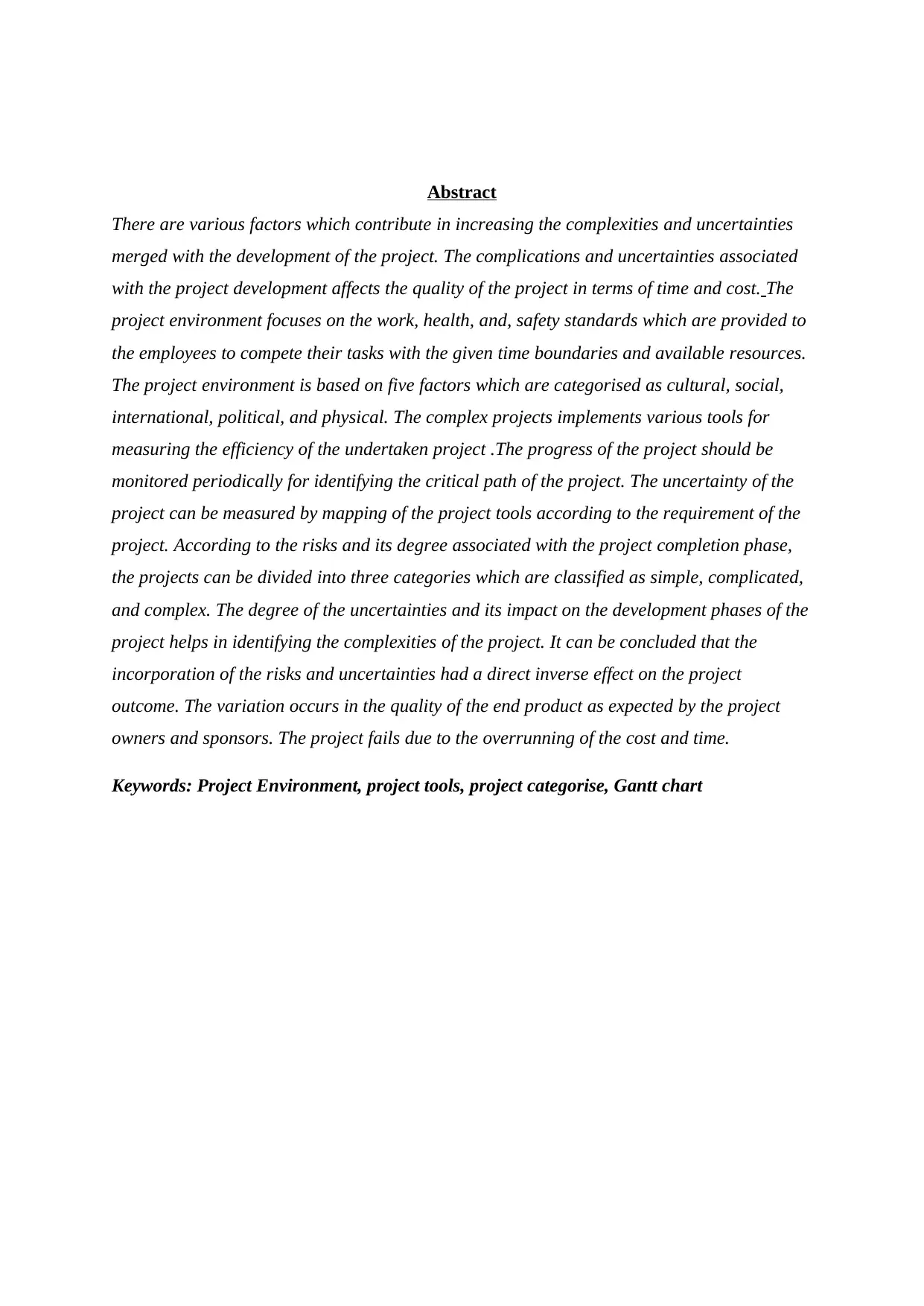
Abstract
There are various factors which contribute in increasing the complexities and uncertainties
merged with the development of the project. The complications and uncertainties associated
with the project development affects the quality of the project in terms of time and cost. The
project environment focuses on the work, health, and, safety standards which are provided to
the employees to compete their tasks with the given time boundaries and available resources.
The project environment is based on five factors which are categorised as cultural, social,
international, political, and physical. The complex projects implements various tools for
measuring the efficiency of the undertaken project .The progress of the project should be
monitored periodically for identifying the critical path of the project. The uncertainty of the
project can be measured by mapping of the project tools according to the requirement of the
project. According to the risks and its degree associated with the project completion phase,
the projects can be divided into three categories which are classified as simple, complicated,
and complex. The degree of the uncertainties and its impact on the development phases of the
project helps in identifying the complexities of the project. It can be concluded that the
incorporation of the risks and uncertainties had a direct inverse effect on the project
outcome. The variation occurs in the quality of the end product as expected by the project
owners and sponsors. The project fails due to the overrunning of the cost and time.
Keywords: Project Environment, project tools, project categorise, Gantt chart
There are various factors which contribute in increasing the complexities and uncertainties
merged with the development of the project. The complications and uncertainties associated
with the project development affects the quality of the project in terms of time and cost. The
project environment focuses on the work, health, and, safety standards which are provided to
the employees to compete their tasks with the given time boundaries and available resources.
The project environment is based on five factors which are categorised as cultural, social,
international, political, and physical. The complex projects implements various tools for
measuring the efficiency of the undertaken project .The progress of the project should be
monitored periodically for identifying the critical path of the project. The uncertainty of the
project can be measured by mapping of the project tools according to the requirement of the
project. According to the risks and its degree associated with the project completion phase,
the projects can be divided into three categories which are classified as simple, complicated,
and complex. The degree of the uncertainties and its impact on the development phases of the
project helps in identifying the complexities of the project. It can be concluded that the
incorporation of the risks and uncertainties had a direct inverse effect on the project
outcome. The variation occurs in the quality of the end product as expected by the project
owners and sponsors. The project fails due to the overrunning of the cost and time.
Keywords: Project Environment, project tools, project categorise, Gantt chart
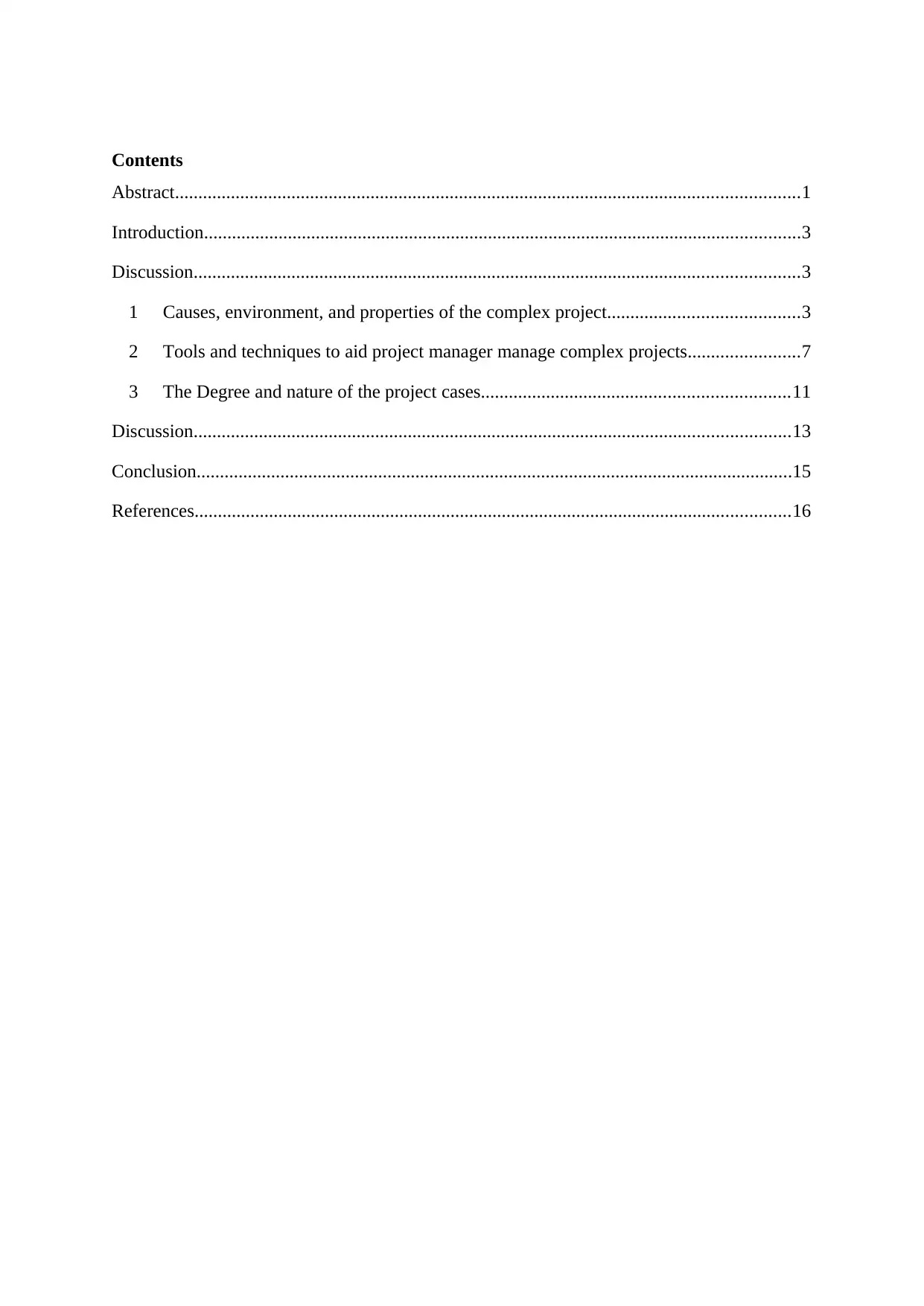
Contents
Abstract......................................................................................................................................1
Introduction................................................................................................................................3
Discussion..................................................................................................................................3
1 Causes, environment, and properties of the complex project.........................................3
2 Tools and techniques to aid project manager manage complex projects........................7
3 The Degree and nature of the project cases..................................................................11
Discussion................................................................................................................................13
Conclusion................................................................................................................................15
References................................................................................................................................16
Abstract......................................................................................................................................1
Introduction................................................................................................................................3
Discussion..................................................................................................................................3
1 Causes, environment, and properties of the complex project.........................................3
2 Tools and techniques to aid project manager manage complex projects........................7
3 The Degree and nature of the project cases..................................................................11
Discussion................................................................................................................................13
Conclusion................................................................................................................................15
References................................................................................................................................16
⊘ This is a preview!⊘
Do you want full access?
Subscribe today to unlock all pages.

Trusted by 1+ million students worldwide
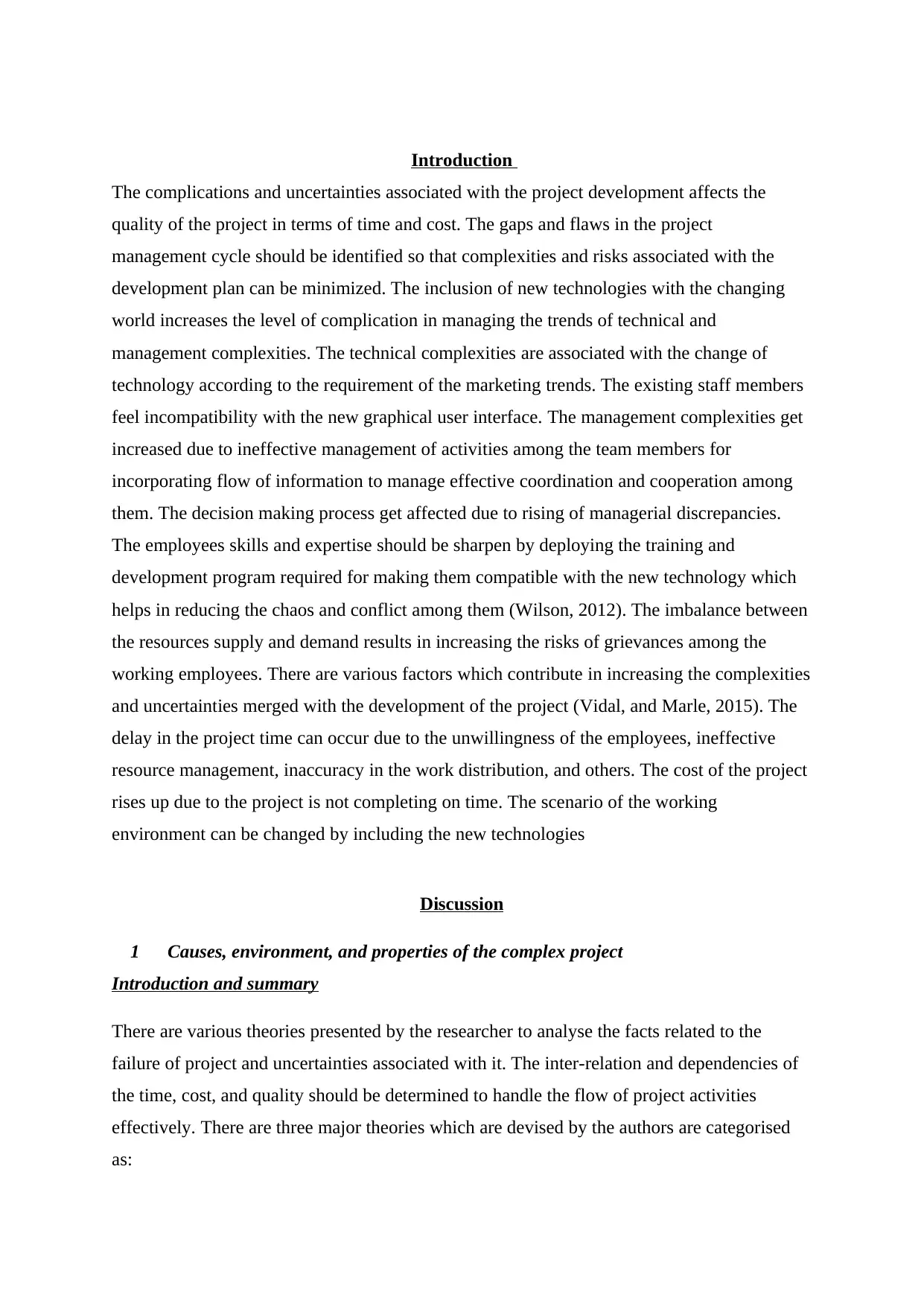
Introduction
The complications and uncertainties associated with the project development affects the
quality of the project in terms of time and cost. The gaps and flaws in the project
management cycle should be identified so that complexities and risks associated with the
development plan can be minimized. The inclusion of new technologies with the changing
world increases the level of complication in managing the trends of technical and
management complexities. The technical complexities are associated with the change of
technology according to the requirement of the marketing trends. The existing staff members
feel incompatibility with the new graphical user interface. The management complexities get
increased due to ineffective management of activities among the team members for
incorporating flow of information to manage effective coordination and cooperation among
them. The decision making process get affected due to rising of managerial discrepancies.
The employees skills and expertise should be sharpen by deploying the training and
development program required for making them compatible with the new technology which
helps in reducing the chaos and conflict among them (Wilson, 2012). The imbalance between
the resources supply and demand results in increasing the risks of grievances among the
working employees. There are various factors which contribute in increasing the complexities
and uncertainties merged with the development of the project (Vidal, and Marle, 2015). The
delay in the project time can occur due to the unwillingness of the employees, ineffective
resource management, inaccuracy in the work distribution, and others. The cost of the project
rises up due to the project is not completing on time. The scenario of the working
environment can be changed by including the new technologies
Discussion
1 Causes, environment, and properties of the complex project
Introduction and summary
There are various theories presented by the researcher to analyse the facts related to the
failure of project and uncertainties associated with it. The inter-relation and dependencies of
the time, cost, and quality should be determined to handle the flow of project activities
effectively. There are three major theories which are devised by the authors are categorised
as:
The complications and uncertainties associated with the project development affects the
quality of the project in terms of time and cost. The gaps and flaws in the project
management cycle should be identified so that complexities and risks associated with the
development plan can be minimized. The inclusion of new technologies with the changing
world increases the level of complication in managing the trends of technical and
management complexities. The technical complexities are associated with the change of
technology according to the requirement of the marketing trends. The existing staff members
feel incompatibility with the new graphical user interface. The management complexities get
increased due to ineffective management of activities among the team members for
incorporating flow of information to manage effective coordination and cooperation among
them. The decision making process get affected due to rising of managerial discrepancies.
The employees skills and expertise should be sharpen by deploying the training and
development program required for making them compatible with the new technology which
helps in reducing the chaos and conflict among them (Wilson, 2012). The imbalance between
the resources supply and demand results in increasing the risks of grievances among the
working employees. There are various factors which contribute in increasing the complexities
and uncertainties merged with the development of the project (Vidal, and Marle, 2015). The
delay in the project time can occur due to the unwillingness of the employees, ineffective
resource management, inaccuracy in the work distribution, and others. The cost of the project
rises up due to the project is not completing on time. The scenario of the working
environment can be changed by including the new technologies
Discussion
1 Causes, environment, and properties of the complex project
Introduction and summary
There are various theories presented by the researcher to analyse the facts related to the
failure of project and uncertainties associated with it. The inter-relation and dependencies of
the time, cost, and quality should be determined to handle the flow of project activities
effectively. There are three major theories which are devised by the authors are categorised
as:
Paraphrase This Document
Need a fresh take? Get an instant paraphrase of this document with our AI Paraphraser
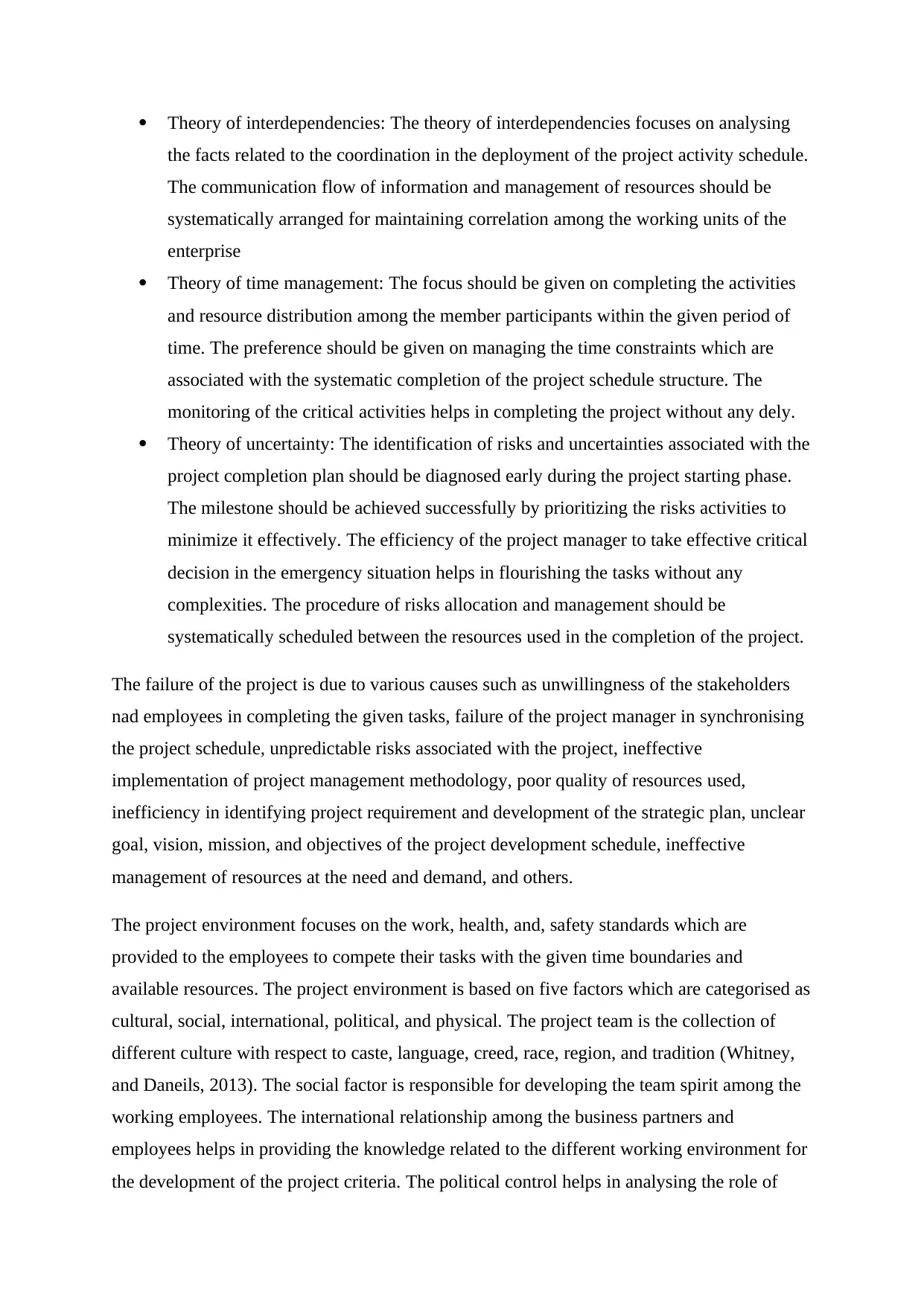
Theory of interdependencies: The theory of interdependencies focuses on analysing
the facts related to the coordination in the deployment of the project activity schedule.
The communication flow of information and management of resources should be
systematically arranged for maintaining correlation among the working units of the
enterprise
Theory of time management: The focus should be given on completing the activities
and resource distribution among the member participants within the given period of
time. The preference should be given on managing the time constraints which are
associated with the systematic completion of the project schedule structure. The
monitoring of the critical activities helps in completing the project without any dely.
Theory of uncertainty: The identification of risks and uncertainties associated with the
project completion plan should be diagnosed early during the project starting phase.
The milestone should be achieved successfully by prioritizing the risks activities to
minimize it effectively. The efficiency of the project manager to take effective critical
decision in the emergency situation helps in flourishing the tasks without any
complexities. The procedure of risks allocation and management should be
systematically scheduled between the resources used in the completion of the project.
The failure of the project is due to various causes such as unwillingness of the stakeholders
nad employees in completing the given tasks, failure of the project manager in synchronising
the project schedule, unpredictable risks associated with the project, ineffective
implementation of project management methodology, poor quality of resources used,
inefficiency in identifying project requirement and development of the strategic plan, unclear
goal, vision, mission, and objectives of the project development schedule, ineffective
management of resources at the need and demand, and others.
The project environment focuses on the work, health, and, safety standards which are
provided to the employees to compete their tasks with the given time boundaries and
available resources. The project environment is based on five factors which are categorised as
cultural, social, international, political, and physical. The project team is the collection of
different culture with respect to caste, language, creed, race, region, and tradition (Whitney,
and Daneils, 2013). The social factor is responsible for developing the team spirit among the
working employees. The international relationship among the business partners and
employees helps in providing the knowledge related to the different working environment for
the development of the project criteria. The political control helps in analysing the role of
the facts related to the coordination in the deployment of the project activity schedule.
The communication flow of information and management of resources should be
systematically arranged for maintaining correlation among the working units of the
enterprise
Theory of time management: The focus should be given on completing the activities
and resource distribution among the member participants within the given period of
time. The preference should be given on managing the time constraints which are
associated with the systematic completion of the project schedule structure. The
monitoring of the critical activities helps in completing the project without any dely.
Theory of uncertainty: The identification of risks and uncertainties associated with the
project completion plan should be diagnosed early during the project starting phase.
The milestone should be achieved successfully by prioritizing the risks activities to
minimize it effectively. The efficiency of the project manager to take effective critical
decision in the emergency situation helps in flourishing the tasks without any
complexities. The procedure of risks allocation and management should be
systematically scheduled between the resources used in the completion of the project.
The failure of the project is due to various causes such as unwillingness of the stakeholders
nad employees in completing the given tasks, failure of the project manager in synchronising
the project schedule, unpredictable risks associated with the project, ineffective
implementation of project management methodology, poor quality of resources used,
inefficiency in identifying project requirement and development of the strategic plan, unclear
goal, vision, mission, and objectives of the project development schedule, ineffective
management of resources at the need and demand, and others.
The project environment focuses on the work, health, and, safety standards which are
provided to the employees to compete their tasks with the given time boundaries and
available resources. The project environment is based on five factors which are categorised as
cultural, social, international, political, and physical. The project team is the collection of
different culture with respect to caste, language, creed, race, region, and tradition (Whitney,
and Daneils, 2013). The social factor is responsible for developing the team spirit among the
working employees. The international relationship among the business partners and
employees helps in providing the knowledge related to the different working environment for
the development of the project criteria. The political control helps in analysing the role of
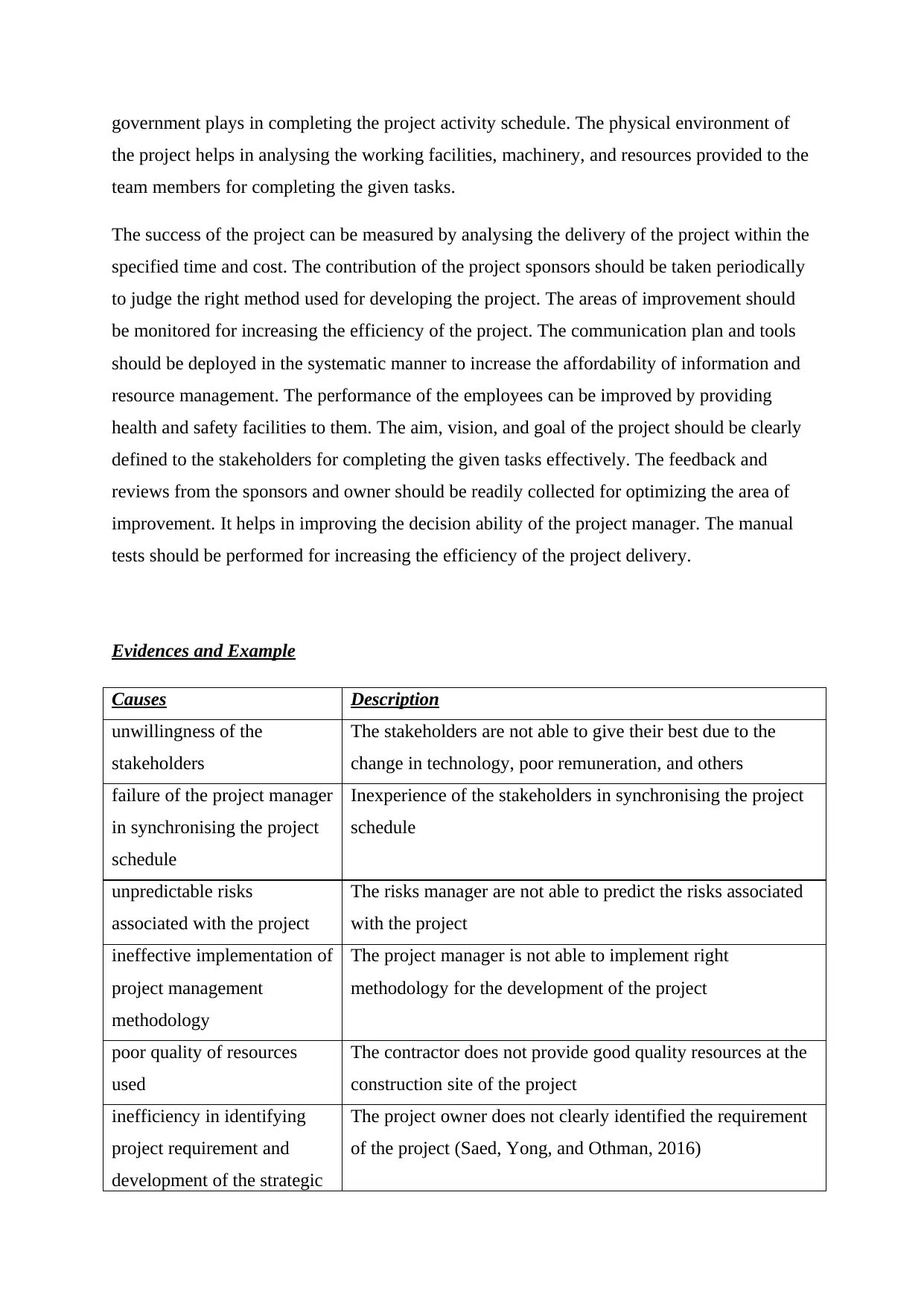
government plays in completing the project activity schedule. The physical environment of
the project helps in analysing the working facilities, machinery, and resources provided to the
team members for completing the given tasks.
The success of the project can be measured by analysing the delivery of the project within the
specified time and cost. The contribution of the project sponsors should be taken periodically
to judge the right method used for developing the project. The areas of improvement should
be monitored for increasing the efficiency of the project. The communication plan and tools
should be deployed in the systematic manner to increase the affordability of information and
resource management. The performance of the employees can be improved by providing
health and safety facilities to them. The aim, vision, and goal of the project should be clearly
defined to the stakeholders for completing the given tasks effectively. The feedback and
reviews from the sponsors and owner should be readily collected for optimizing the area of
improvement. It helps in improving the decision ability of the project manager. The manual
tests should be performed for increasing the efficiency of the project delivery.
Evidences and Example
Causes Description
unwillingness of the
stakeholders
The stakeholders are not able to give their best due to the
change in technology, poor remuneration, and others
failure of the project manager
in synchronising the project
schedule
Inexperience of the stakeholders in synchronising the project
schedule
unpredictable risks
associated with the project
The risks manager are not able to predict the risks associated
with the project
ineffective implementation of
project management
methodology
The project manager is not able to implement right
methodology for the development of the project
poor quality of resources
used
The contractor does not provide good quality resources at the
construction site of the project
inefficiency in identifying
project requirement and
development of the strategic
The project owner does not clearly identified the requirement
of the project (Saed, Yong, and Othman, 2016)
the project helps in analysing the working facilities, machinery, and resources provided to the
team members for completing the given tasks.
The success of the project can be measured by analysing the delivery of the project within the
specified time and cost. The contribution of the project sponsors should be taken periodically
to judge the right method used for developing the project. The areas of improvement should
be monitored for increasing the efficiency of the project. The communication plan and tools
should be deployed in the systematic manner to increase the affordability of information and
resource management. The performance of the employees can be improved by providing
health and safety facilities to them. The aim, vision, and goal of the project should be clearly
defined to the stakeholders for completing the given tasks effectively. The feedback and
reviews from the sponsors and owner should be readily collected for optimizing the area of
improvement. It helps in improving the decision ability of the project manager. The manual
tests should be performed for increasing the efficiency of the project delivery.
Evidences and Example
Causes Description
unwillingness of the
stakeholders
The stakeholders are not able to give their best due to the
change in technology, poor remuneration, and others
failure of the project manager
in synchronising the project
schedule
Inexperience of the stakeholders in synchronising the project
schedule
unpredictable risks
associated with the project
The risks manager are not able to predict the risks associated
with the project
ineffective implementation of
project management
methodology
The project manager is not able to implement right
methodology for the development of the project
poor quality of resources
used
The contractor does not provide good quality resources at the
construction site of the project
inefficiency in identifying
project requirement and
development of the strategic
The project owner does not clearly identified the requirement
of the project (Saed, Yong, and Othman, 2016)
⊘ This is a preview!⊘
Do you want full access?
Subscribe today to unlock all pages.

Trusted by 1+ million students worldwide
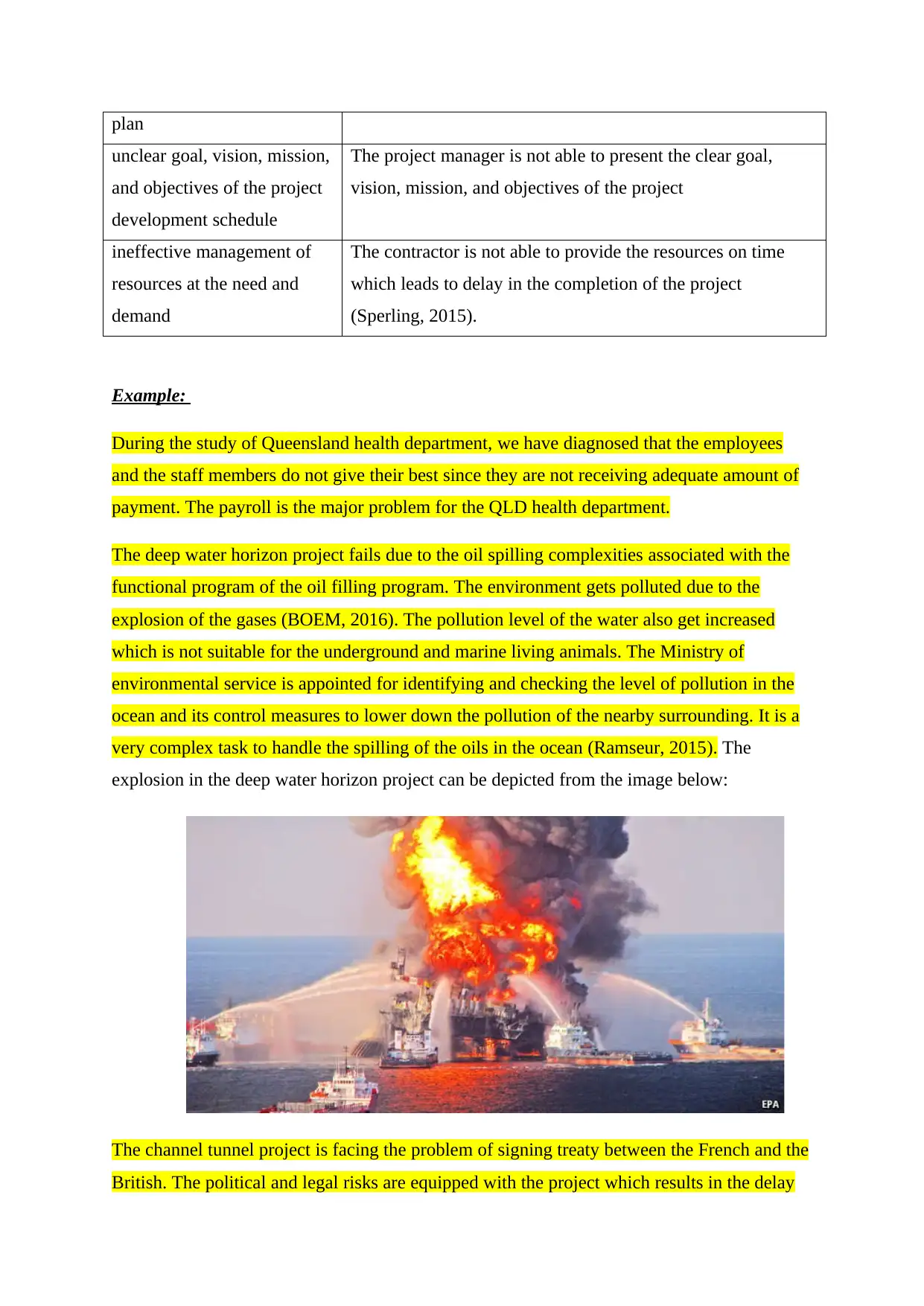
plan
unclear goal, vision, mission,
and objectives of the project
development schedule
The project manager is not able to present the clear goal,
vision, mission, and objectives of the project
ineffective management of
resources at the need and
demand
The contractor is not able to provide the resources on time
which leads to delay in the completion of the project
(Sperling, 2015).
Example:
During the study of Queensland health department, we have diagnosed that the employees
and the staff members do not give their best since they are not receiving adequate amount of
payment. The payroll is the major problem for the QLD health department.
The deep water horizon project fails due to the oil spilling complexities associated with the
functional program of the oil filling program. The environment gets polluted due to the
explosion of the gases (BOEM, 2016). The pollution level of the water also get increased
which is not suitable for the underground and marine living animals. The Ministry of
environmental service is appointed for identifying and checking the level of pollution in the
ocean and its control measures to lower down the pollution of the nearby surrounding. It is a
very complex task to handle the spilling of the oils in the ocean (Ramseur, 2015). The
explosion in the deep water horizon project can be depicted from the image below:
The channel tunnel project is facing the problem of signing treaty between the French and the
British. The political and legal risks are equipped with the project which results in the delay
unclear goal, vision, mission,
and objectives of the project
development schedule
The project manager is not able to present the clear goal,
vision, mission, and objectives of the project
ineffective management of
resources at the need and
demand
The contractor is not able to provide the resources on time
which leads to delay in the completion of the project
(Sperling, 2015).
Example:
During the study of Queensland health department, we have diagnosed that the employees
and the staff members do not give their best since they are not receiving adequate amount of
payment. The payroll is the major problem for the QLD health department.
The deep water horizon project fails due to the oil spilling complexities associated with the
functional program of the oil filling program. The environment gets polluted due to the
explosion of the gases (BOEM, 2016). The pollution level of the water also get increased
which is not suitable for the underground and marine living animals. The Ministry of
environmental service is appointed for identifying and checking the level of pollution in the
ocean and its control measures to lower down the pollution of the nearby surrounding. It is a
very complex task to handle the spilling of the oils in the ocean (Ramseur, 2015). The
explosion in the deep water horizon project can be depicted from the image below:
The channel tunnel project is facing the problem of signing treaty between the French and the
British. The political and legal risks are equipped with the project which results in the delay
Paraphrase This Document
Need a fresh take? Get an instant paraphrase of this document with our AI Paraphraser
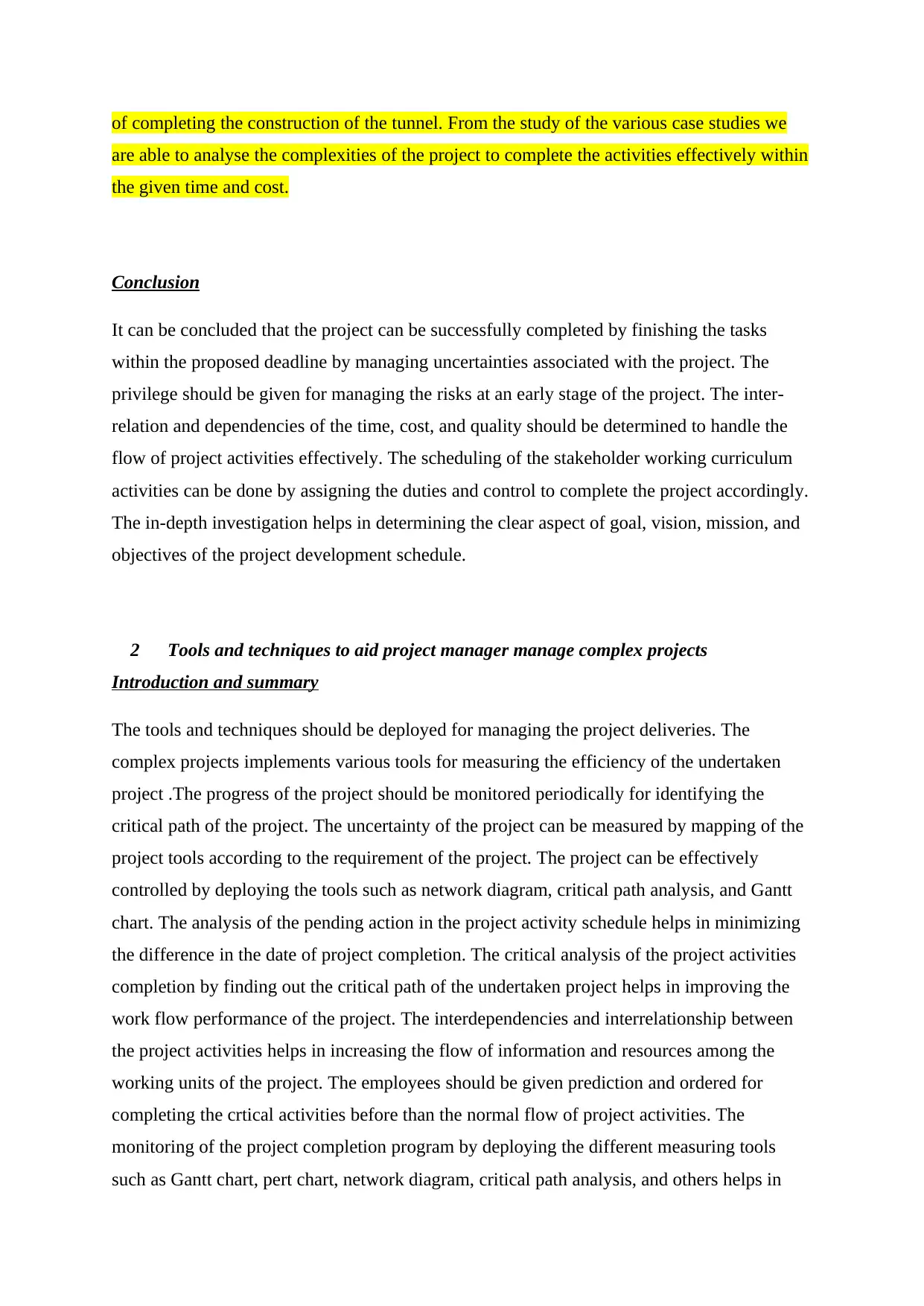
of completing the construction of the tunnel. From the study of the various case studies we
are able to analyse the complexities of the project to complete the activities effectively within
the given time and cost.
Conclusion
It can be concluded that the project can be successfully completed by finishing the tasks
within the proposed deadline by managing uncertainties associated with the project. The
privilege should be given for managing the risks at an early stage of the project. The inter-
relation and dependencies of the time, cost, and quality should be determined to handle the
flow of project activities effectively. The scheduling of the stakeholder working curriculum
activities can be done by assigning the duties and control to complete the project accordingly.
The in-depth investigation helps in determining the clear aspect of goal, vision, mission, and
objectives of the project development schedule.
2 Tools and techniques to aid project manager manage complex projects
Introduction and summary
The tools and techniques should be deployed for managing the project deliveries. The
complex projects implements various tools for measuring the efficiency of the undertaken
project .The progress of the project should be monitored periodically for identifying the
critical path of the project. The uncertainty of the project can be measured by mapping of the
project tools according to the requirement of the project. The project can be effectively
controlled by deploying the tools such as network diagram, critical path analysis, and Gantt
chart. The analysis of the pending action in the project activity schedule helps in minimizing
the difference in the date of project completion. The critical analysis of the project activities
completion by finding out the critical path of the undertaken project helps in improving the
work flow performance of the project. The interdependencies and interrelationship between
the project activities helps in increasing the flow of information and resources among the
working units of the project. The employees should be given prediction and ordered for
completing the crtical activities before than the normal flow of project activities. The
monitoring of the project completion program by deploying the different measuring tools
such as Gantt chart, pert chart, network diagram, critical path analysis, and others helps in
are able to analyse the complexities of the project to complete the activities effectively within
the given time and cost.
Conclusion
It can be concluded that the project can be successfully completed by finishing the tasks
within the proposed deadline by managing uncertainties associated with the project. The
privilege should be given for managing the risks at an early stage of the project. The inter-
relation and dependencies of the time, cost, and quality should be determined to handle the
flow of project activities effectively. The scheduling of the stakeholder working curriculum
activities can be done by assigning the duties and control to complete the project accordingly.
The in-depth investigation helps in determining the clear aspect of goal, vision, mission, and
objectives of the project development schedule.
2 Tools and techniques to aid project manager manage complex projects
Introduction and summary
The tools and techniques should be deployed for managing the project deliveries. The
complex projects implements various tools for measuring the efficiency of the undertaken
project .The progress of the project should be monitored periodically for identifying the
critical path of the project. The uncertainty of the project can be measured by mapping of the
project tools according to the requirement of the project. The project can be effectively
controlled by deploying the tools such as network diagram, critical path analysis, and Gantt
chart. The analysis of the pending action in the project activity schedule helps in minimizing
the difference in the date of project completion. The critical analysis of the project activities
completion by finding out the critical path of the undertaken project helps in improving the
work flow performance of the project. The interdependencies and interrelationship between
the project activities helps in increasing the flow of information and resources among the
working units of the project. The employees should be given prediction and ordered for
completing the crtical activities before than the normal flow of project activities. The
monitoring of the project completion program by deploying the different measuring tools
such as Gantt chart, pert chart, network diagram, critical path analysis, and others helps in
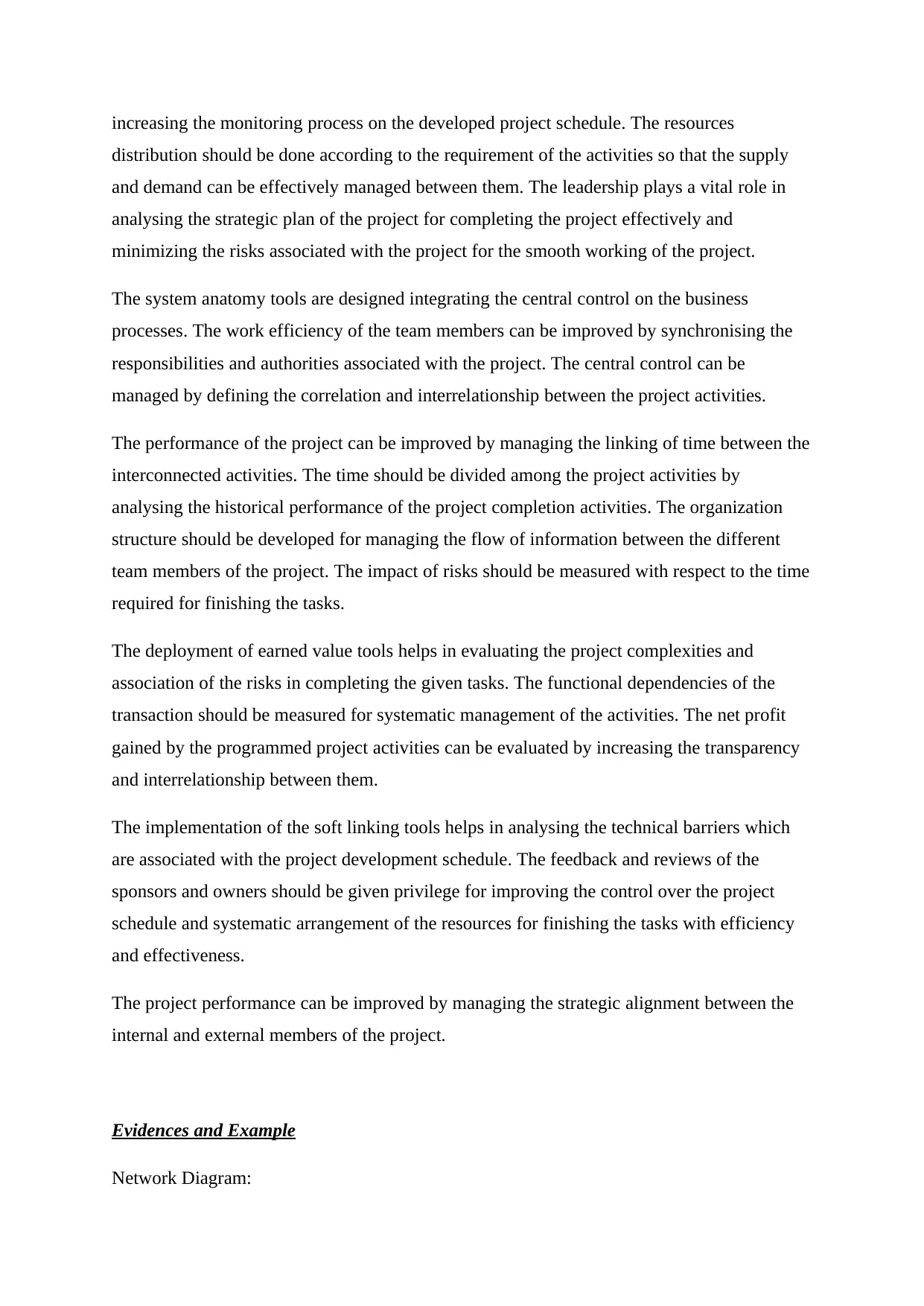
increasing the monitoring process on the developed project schedule. The resources
distribution should be done according to the requirement of the activities so that the supply
and demand can be effectively managed between them. The leadership plays a vital role in
analysing the strategic plan of the project for completing the project effectively and
minimizing the risks associated with the project for the smooth working of the project.
The system anatomy tools are designed integrating the central control on the business
processes. The work efficiency of the team members can be improved by synchronising the
responsibilities and authorities associated with the project. The central control can be
managed by defining the correlation and interrelationship between the project activities.
The performance of the project can be improved by managing the linking of time between the
interconnected activities. The time should be divided among the project activities by
analysing the historical performance of the project completion activities. The organization
structure should be developed for managing the flow of information between the different
team members of the project. The impact of risks should be measured with respect to the time
required for finishing the tasks.
The deployment of earned value tools helps in evaluating the project complexities and
association of the risks in completing the given tasks. The functional dependencies of the
transaction should be measured for systematic management of the activities. The net profit
gained by the programmed project activities can be evaluated by increasing the transparency
and interrelationship between them.
The implementation of the soft linking tools helps in analysing the technical barriers which
are associated with the project development schedule. The feedback and reviews of the
sponsors and owners should be given privilege for improving the control over the project
schedule and systematic arrangement of the resources for finishing the tasks with efficiency
and effectiveness.
The project performance can be improved by managing the strategic alignment between the
internal and external members of the project.
Evidences and Example
Network Diagram:
distribution should be done according to the requirement of the activities so that the supply
and demand can be effectively managed between them. The leadership plays a vital role in
analysing the strategic plan of the project for completing the project effectively and
minimizing the risks associated with the project for the smooth working of the project.
The system anatomy tools are designed integrating the central control on the business
processes. The work efficiency of the team members can be improved by synchronising the
responsibilities and authorities associated with the project. The central control can be
managed by defining the correlation and interrelationship between the project activities.
The performance of the project can be improved by managing the linking of time between the
interconnected activities. The time should be divided among the project activities by
analysing the historical performance of the project completion activities. The organization
structure should be developed for managing the flow of information between the different
team members of the project. The impact of risks should be measured with respect to the time
required for finishing the tasks.
The deployment of earned value tools helps in evaluating the project complexities and
association of the risks in completing the given tasks. The functional dependencies of the
transaction should be measured for systematic management of the activities. The net profit
gained by the programmed project activities can be evaluated by increasing the transparency
and interrelationship between them.
The implementation of the soft linking tools helps in analysing the technical barriers which
are associated with the project development schedule. The feedback and reviews of the
sponsors and owners should be given privilege for improving the control over the project
schedule and systematic arrangement of the resources for finishing the tasks with efficiency
and effectiveness.
The project performance can be improved by managing the strategic alignment between the
internal and external members of the project.
Evidences and Example
Network Diagram:
⊘ This is a preview!⊘
Do you want full access?
Subscribe today to unlock all pages.

Trusted by 1+ million students worldwide
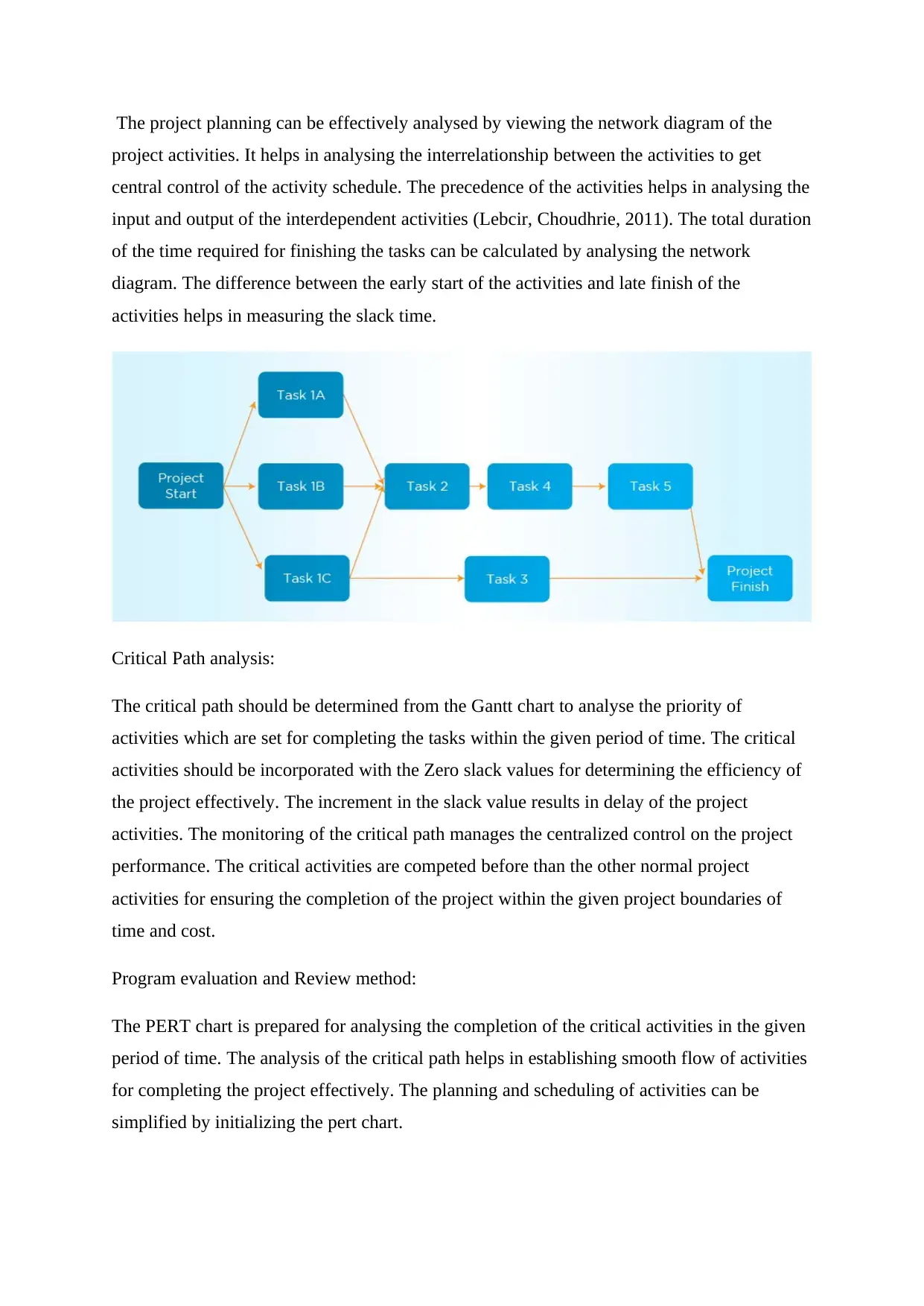
The project planning can be effectively analysed by viewing the network diagram of the
project activities. It helps in analysing the interrelationship between the activities to get
central control of the activity schedule. The precedence of the activities helps in analysing the
input and output of the interdependent activities (Lebcir, Choudhrie, 2011). The total duration
of the time required for finishing the tasks can be calculated by analysing the network
diagram. The difference between the early start of the activities and late finish of the
activities helps in measuring the slack time.
Critical Path analysis:
The critical path should be determined from the Gantt chart to analyse the priority of
activities which are set for completing the tasks within the given period of time. The critical
activities should be incorporated with the Zero slack values for determining the efficiency of
the project effectively. The increment in the slack value results in delay of the project
activities. The monitoring of the critical path manages the centralized control on the project
performance. The critical activities are competed before than the other normal project
activities for ensuring the completion of the project within the given project boundaries of
time and cost.
Program evaluation and Review method:
The PERT chart is prepared for analysing the completion of the critical activities in the given
period of time. The analysis of the critical path helps in establishing smooth flow of activities
for completing the project effectively. The planning and scheduling of activities can be
simplified by initializing the pert chart.
project activities. It helps in analysing the interrelationship between the activities to get
central control of the activity schedule. The precedence of the activities helps in analysing the
input and output of the interdependent activities (Lebcir, Choudhrie, 2011). The total duration
of the time required for finishing the tasks can be calculated by analysing the network
diagram. The difference between the early start of the activities and late finish of the
activities helps in measuring the slack time.
Critical Path analysis:
The critical path should be determined from the Gantt chart to analyse the priority of
activities which are set for completing the tasks within the given period of time. The critical
activities should be incorporated with the Zero slack values for determining the efficiency of
the project effectively. The increment in the slack value results in delay of the project
activities. The monitoring of the critical path manages the centralized control on the project
performance. The critical activities are competed before than the other normal project
activities for ensuring the completion of the project within the given project boundaries of
time and cost.
Program evaluation and Review method:
The PERT chart is prepared for analysing the completion of the critical activities in the given
period of time. The analysis of the critical path helps in establishing smooth flow of activities
for completing the project effectively. The planning and scheduling of activities can be
simplified by initializing the pert chart.
Paraphrase This Document
Need a fresh take? Get an instant paraphrase of this document with our AI Paraphraser
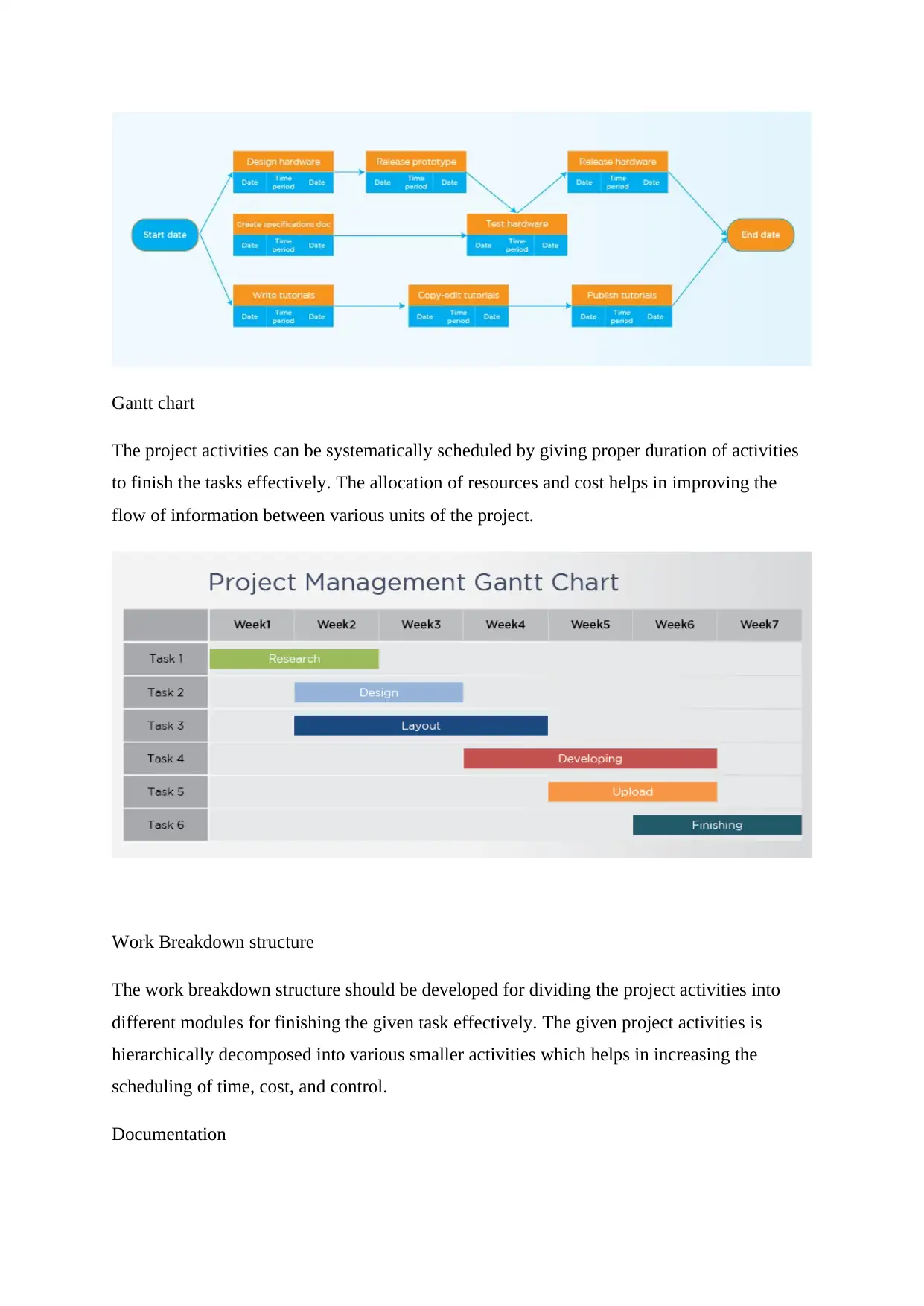
Gantt chart
The project activities can be systematically scheduled by giving proper duration of activities
to finish the tasks effectively. The allocation of resources and cost helps in improving the
flow of information between various units of the project.
Work Breakdown structure
The work breakdown structure should be developed for dividing the project activities into
different modules for finishing the given task effectively. The given project activities is
hierarchically decomposed into various smaller activities which helps in increasing the
scheduling of time, cost, and control.
Documentation
The project activities can be systematically scheduled by giving proper duration of activities
to finish the tasks effectively. The allocation of resources and cost helps in improving the
flow of information between various units of the project.
Work Breakdown structure
The work breakdown structure should be developed for dividing the project activities into
different modules for finishing the given task effectively. The given project activities is
hierarchically decomposed into various smaller activities which helps in increasing the
scheduling of time, cost, and control.
Documentation
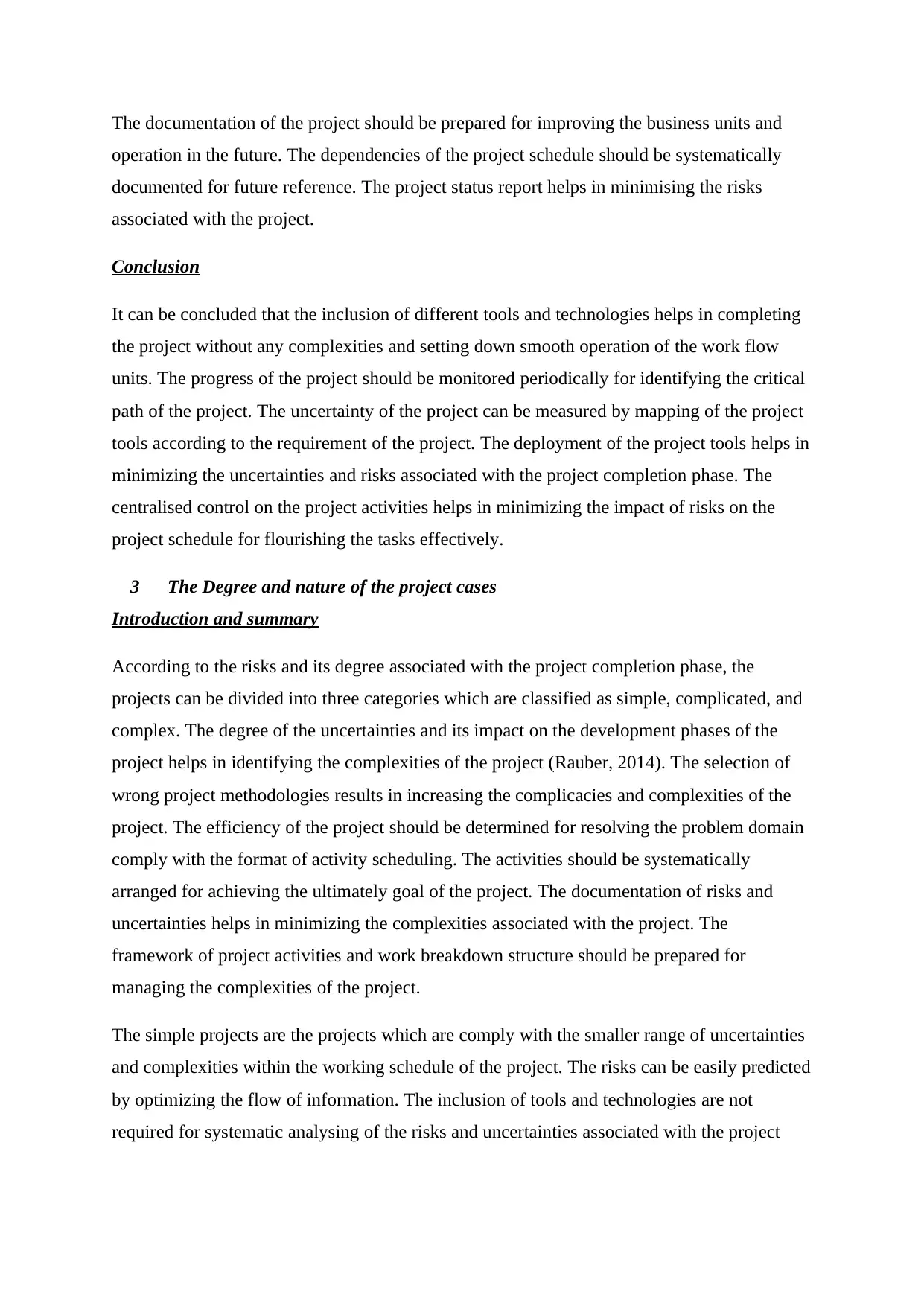
The documentation of the project should be prepared for improving the business units and
operation in the future. The dependencies of the project schedule should be systematically
documented for future reference. The project status report helps in minimising the risks
associated with the project.
Conclusion
It can be concluded that the inclusion of different tools and technologies helps in completing
the project without any complexities and setting down smooth operation of the work flow
units. The progress of the project should be monitored periodically for identifying the critical
path of the project. The uncertainty of the project can be measured by mapping of the project
tools according to the requirement of the project. The deployment of the project tools helps in
minimizing the uncertainties and risks associated with the project completion phase. The
centralised control on the project activities helps in minimizing the impact of risks on the
project schedule for flourishing the tasks effectively.
3 The Degree and nature of the project cases
Introduction and summary
According to the risks and its degree associated with the project completion phase, the
projects can be divided into three categories which are classified as simple, complicated, and
complex. The degree of the uncertainties and its impact on the development phases of the
project helps in identifying the complexities of the project (Rauber, 2014). The selection of
wrong project methodologies results in increasing the complicacies and complexities of the
project. The efficiency of the project should be determined for resolving the problem domain
comply with the format of activity scheduling. The activities should be systematically
arranged for achieving the ultimately goal of the project. The documentation of risks and
uncertainties helps in minimizing the complexities associated with the project. The
framework of project activities and work breakdown structure should be prepared for
managing the complexities of the project.
The simple projects are the projects which are comply with the smaller range of uncertainties
and complexities within the working schedule of the project. The risks can be easily predicted
by optimizing the flow of information. The inclusion of tools and technologies are not
required for systematic analysing of the risks and uncertainties associated with the project
operation in the future. The dependencies of the project schedule should be systematically
documented for future reference. The project status report helps in minimising the risks
associated with the project.
Conclusion
It can be concluded that the inclusion of different tools and technologies helps in completing
the project without any complexities and setting down smooth operation of the work flow
units. The progress of the project should be monitored periodically for identifying the critical
path of the project. The uncertainty of the project can be measured by mapping of the project
tools according to the requirement of the project. The deployment of the project tools helps in
minimizing the uncertainties and risks associated with the project completion phase. The
centralised control on the project activities helps in minimizing the impact of risks on the
project schedule for flourishing the tasks effectively.
3 The Degree and nature of the project cases
Introduction and summary
According to the risks and its degree associated with the project completion phase, the
projects can be divided into three categories which are classified as simple, complicated, and
complex. The degree of the uncertainties and its impact on the development phases of the
project helps in identifying the complexities of the project (Rauber, 2014). The selection of
wrong project methodologies results in increasing the complicacies and complexities of the
project. The efficiency of the project should be determined for resolving the problem domain
comply with the format of activity scheduling. The activities should be systematically
arranged for achieving the ultimately goal of the project. The documentation of risks and
uncertainties helps in minimizing the complexities associated with the project. The
framework of project activities and work breakdown structure should be prepared for
managing the complexities of the project.
The simple projects are the projects which are comply with the smaller range of uncertainties
and complexities within the working schedule of the project. The risks can be easily predicted
by optimizing the flow of information. The inclusion of tools and technologies are not
required for systematic analysing of the risks and uncertainties associated with the project
⊘ This is a preview!⊘
Do you want full access?
Subscribe today to unlock all pages.

Trusted by 1+ million students worldwide
1 out of 19
Related Documents
Your All-in-One AI-Powered Toolkit for Academic Success.
+13062052269
info@desklib.com
Available 24*7 on WhatsApp / Email
![[object Object]](/_next/static/media/star-bottom.7253800d.svg)
Unlock your academic potential
Copyright © 2020–2025 A2Z Services. All Rights Reserved. Developed and managed by ZUCOL.





